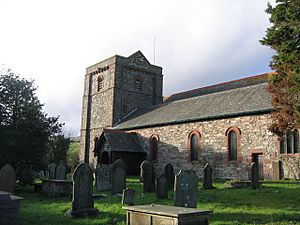St Mary Magdalene's Church, Broughton-in-Furness facts for kids
Quick facts for kids St Mary Magdalene's Church |
|
|---|---|

St Mary Magdalene's Church from the southeast
|
|
| Lua error in Module:Location_map at line 420: attempt to index field 'wikibase' (a nil value). | |
| OS grid reference | SD 209,874 |
| Location | Broughton-in-Furness, Cumbria |
| Country | England |
| Denomination | Anglican |
| Website | St Mary Magdalene, Broughton-in-Furness |
| History | |
| Status | Parish church |
| Dedication | Mary Magdalene |
| Architecture | |
| Functional status | Active |
| Heritage designation | Grade II |
| Designated | 5 March 1990 |
| Architect(s) | Paley and Austin, Austin and Paley |
| Architectural type | Church |
| Specifications | |
| Materials | Stone, slate roofs |
| Administration | |
| Parish | Broughton and Duddon |
| Deanery | Furness |
| Archdeaconry | Westmorland and Furness |
| Diocese | Carlisle |
| Province | York |
St Mary Magdalene's Church is a special old church located in Broughton-in-Furness, a town in Cumbria, England. It's an active church where people still go for services. It belongs to the Church of England. This church is considered a very important historical building. It is officially listed as a Grade II building, which means it's protected because of its history and architecture. The church is named after Mary Magdalene, a companion of Jesus.
Contents
History of the Church Building
The oldest part of the church is the south doorway. It was built a very long time ago in the 12th century. This was during a time called the Norman period. Over the years, the church was changed and added to. This happened especially in the 16th and 19th centuries.
In 1873 and 1874, the church was "restored" by architects named Paley and Austin. Restoring a church means fixing it up and making it look new again. They rebuilt the main part of the church, called the nave. They also fixed the chancel, which is the area near the altar. A new side section, called an aisle, was added too. They used special stone from St Bees for the outside details. The inside walls were covered with Runcorn sandstone.
Later, in 1900, the church's tower was replaced. This work was done by Austin and Paley, who took over from Paley and Austin. The money for these improvements came from a generous person named Lord Cross. He also gave the church a set of bells.
What the Church Looks Like
The church is built from stone pieces called rubble. It has smooth, cut stones called ashlar for details. The roofs are made of slate. The church has a main hall (nave) with five sections, and a chancel with three sections. It also has a side aisle, a porch, and a tower on the southwest side.
The windows and bell openings are rounded at the top. This style matches the old Norman doorway. The tower has three levels. It has strong supports called buttresses and a decorative stone band called a corbel table. At the very top, there is a flat wall called a parapet with pointed decorations called gablets. The openings for the bells have angled slats called louvres.
Inside, the arches that separate the nave from the aisle are supported by round pillars. In the aisle, there is a restored piscina. This is a small basin used for washing sacred vessels. The church also has beautiful stained glass windows. Some of these were made by famous artists like Kempe, Shrigley and Hunt, and William Morris. The designs for Morris's windows were created by Burne-Jones.
Things Outside the Church
In the churchyard, which is the area around the church, there are three more Grade II listed buildings. These are also protected because of their historical importance.
- One is a sundial. It might be the bottom part of a medieval churchyard cross.
- Another is the Atkinson monument, which is a headstone from 1805.
- There is also a group of four tombs. These tombs date from the late 1700s and early 1800s.
The church tower has a set of 12 bells. It originally had 8 bells, then 10, and finally 12.
See also
- Listed buildings in Broughton West
- List of ecclesiastical works by Paley and Austin
- List of ecclesiastical works by Austin and Paley (1895–1914)

